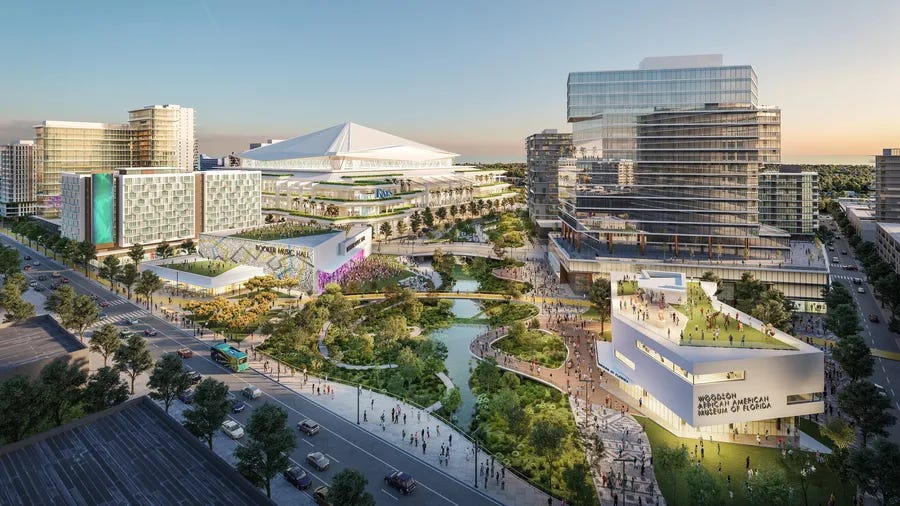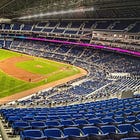A ray of hope?
Today will be a day of celebration for the Tampa Bay Rays, but will a new ballpark in St. Petersburg really transform the franchise?

TicketRev is the presenting sponsor of VIEW FROM THE BLEACHERS. Click to learn more, and download the TicketRev app on the App Store and Google Play to save on tickets to see the Marlins on their final homestand, the Dolphins, the Canes, Inter Miami and the rest of the games and concerts you don’t want to miss.
The news Tampa Bay Rays fans have been waiting to hear for years was broken by Mark Topkin of The Tampa Bay Times early yesterday. And it’s expected to be made official by the ballclub and local political leaders today.
The Rays have an agreement in place to finance and build a 30,000-seat domed stadium to replace dreary Tropicana Field and—at long last—secure the future of Major League Baseball on Florida’s Suncoast.
The $1.2 billion ballpark is expected to open in 2028, which will be the Rays’ 30th anniversary season.
After a dreadful first decade—both on and off the field—the Rays have been a modern major league marvel since 2008, annually fielding competitive teams in the rugged American League East despite paltry attendance, limited revenue, a payroll perennially at or near the bottom of the sport and an on-going struggle to get a new home built.
In 2023, the Rays are headed to the playoffs for the 5th consecutive season, a club record. They’ll play in October for the 9th time in the last 16 seasons despite having their baseball operations leadership raided by other clubs on a regular basis and despite fielding a roster that’s comprised of a rotating cast of young home-grown prospects and imported talent that was under-valued or under-utilized elsewhere.
When one productive player most fans around the league don’t know much about goes down, it’s next man up. And the Rays keep winning.
While members of star-studded, mega-payroll teams like the Mets, Padres, Yankees and Angels pack up their lockers and prepare to head home for the winter, Tigers castoff Isaac Paredes, former Cardinal Randy Arozarena, former Indian Yandy Diaz, former Marlin and Guardian Harold Ramirez and former Phillie Zach Eflin prepare to lead the Rays into October and again onto the Game’s biggest stage.
Despite the 3rd-lowest Opening Day payroll in Baseball, this Tampa Bay club has an outside shot at the 2nd 100-win season in franchise history and a chance to return to the World Series for the 3rd time since 2008.
So it’s an exciting time for the Rays, and—with yesterday’s news—the promise of tomorrow seems unlimited.
BUT… (There’s almost always a “but,” isn’t there?)
By now, most baseball fans know the song by heart.
As the Times wrote yesterday, the new Rays ballpark “is expected to lead to increased revenues via higher attendance and more sponsorship deals that team officials say will allow them to improve facilities and increase player payroll.”
It sounds great on paper. But are you sure about that?
If the Rays look 268 miles to the south their confidence may be shaken.
Has loanDepot park been the panacea to all that historically ailed the Marlins?
In 2023, their 12th season in the park and their 6th season under new ownership, the Marlins have a shot to reach the playoffs in a full season for the first time since 2003. They stand 29th in MLB in attendance and remain near the bottom of the sport in revenue. Their Opening Day payroll ranked 23rd out of the 30 clubs.
The new ballpark hasn’t allowed the Marlins to keep their star players.
Giancarlo Stanton was traded to the New York Yankees December 11, 2017, 27 days after winning the Marlins’ first-ever NL Most Valuable Player Award.
Christian Yelich was traded to Milwaukee January 25, 2018 and went on to win the NL MVP award in his first season as a Brewer.
Coming off a 37-homer, 124-RBI season in 2017, Marcell Ozuna was traded to the St. Louis Cardinals and has hit 35 homers this year for the ML-best Atlanta Braves.
J.T. Realmuto, widely regarded as the best catcher in MLB, was dealt to the Phillies prior to the 2019 season, helped the Phils to a pennant last season and will again play in October for Philadelphia this season.
Those players were all sent packing by a new owner who decided that 1) He couldn’t win with them and 2) He couldn’t afford to keep them even in a new ballpark that was supposed to have led to (everybody sing) “increased revenues via higher attendance and more sponsorship deals that team officials say will allow them to improve facilities and increase player payroll.”
Shouldn’t that cautionary tale concern the Rays when they come down from the high of the bunting and balloons, the pomp and circumstance that will accompany today’s official announcement?
HERE’S THE BIGGEST THING
While no 2 situations are exactly the same, there is one massive parallel between the Miami and Tampa Bay situations, and you would think someone with the Rays would have realized this:
It’s not just about building a ballpark. As we’ve seen with the Marlins, building a spectacular ballpark in an area that is either inconvenient or unappealing to fans is a recipe for disaster.
This was discussed at length in a piece I wrote in June, part of a 4-part series discussing what fans said it would take to get them to attend more Marlins games.
The answer I got more than any other was the location of the ballpark was a deal breaker. Building the ballpark in a location where fans have said they will not attend games regularly was a huge mistake for the Marlins, the City of Miami and Miami-Dade County.
And that’s precisely what the Rays, the City of St. Petersburg and Pinellas County are planning to do.
Since the Rays were born in 1998, fans on the highly-populated Tampa side of Tampa Bay have made it clear they will not regularly cross the bridge into St. Petersburg—especially at Rush Hour—to attend Rays games. There’s more corporate money in Tampa, and it’s staying there. Meanwhile, potential fans in Orlando and along the I-4 Corridor have been reluctant to make the extended drive through Tampa, across the bridge and into St. Petersburg.
But where will the new ballpark be built? In St. Pete, right next to the site where Tropicana Field stands today.
In the giddiness to get a new ballpark built, the Rays are choosing to ignore the fact that the single biggest roadblock to attendance they have faced historically will still be there after they cut the ribbon on their new home in 2028.
The bells and whistles and the new-car smell are meaningless if people don’t want to go where you’re going to spend $1.2 billion to build a ballpark.
Why has Truist Park in Atlanta been a massive success? Because the Braves built their new home—and a massive entertainment district—in suburban Cobb County, convenient to where most of their fans live. No longer would the bulk of their fan base have to drive directly through the heart of downtown Atlanta at Rush Hour to get to ballgames.
Why has Petco Park in San Diego been a massive success? Because the Padres left suburban Mission Valley for the heart of one of America’s friendliest and liveliest downtowns, with countless restaurants and bars within a short walk of home plate, so fans can come early and stay late.
In those instances—and many others, all with circumstances unique to individual cities—teams have built the right ballpark in the right location.
loanDepot park is a terrific place to watch a Major League Baseball game. But it is not convenient for potential fans who live in Broward or Palm Beach counties, and Little Havana is not a come-early, stay-late destination for baseball fans and families.
The situation is exactly the same where the Rays plan to build their new ballpark.
I’ve discussed this before. Ballparks get built where the money is. Fans who complain the Marlins should have built their ballpark in Broward County are ignoring the fact that Broward was never an option. While Broward may have made more sense, there was never money to build a park to the north. The City of Miami and Miami-Dade County are the entities that stepped up and entered a public-private partnership with Jeffrey Loria to build a new ballpark. That’s how the ballpark ended up on the Orange Bowl site.
Tampa, while the best option for the Rays, has not been an option. Neither the city nor Hillsborough County has stepped up to contribute financially, while St. Petersburg and Pinellas County will reportedly pay for approximately half of the new ballpark project.
That’s the reality of the situation.
Come 2028, the Tampa Bay Rays will likely have a sparkling new home. But before the first shovel even goes into the ground, the Rays, the city and the county would be wise to look to the south where they will see that simply building a new ballpark is far from transformational.
Just ask the 14,000 a night who are bothering to show up in the heat of a pennant race in Miami and the owner who remains hamstrung by a lack of revenue in the 3rd-newest ballpark in MLB.
While you’re here…
Interested in advertising on VIEW FROM THE BLEACHERS? Contact me here to learn about opportunities to promote your business on a daily or weekly basis.
Learn more about one-on-one play-by-play coaching from Glenn Geffner via Zoom at glenngeffner.com.
Your feedback is always appreciated. Hit the “LIKE” button below if you enjoyed this post.






I loved the idea of moving the team to Orlando and opening up both markets. Even Lakeland or the Plant City area should be better. You can keep the name. I worked as a clubbie for the Rays 18 years ago when Spring Training was still in St. Pete. A big part of my job was taking cut players to the airport. Half my day was spent on that bridge. It's a nightmare. This just seems like an obviously dumb move.
LOCATION, LOCATION, LOCATION....................IT IS AN AXIOM - MUST BE FOLLOWED TO BE SUCCESSFUL